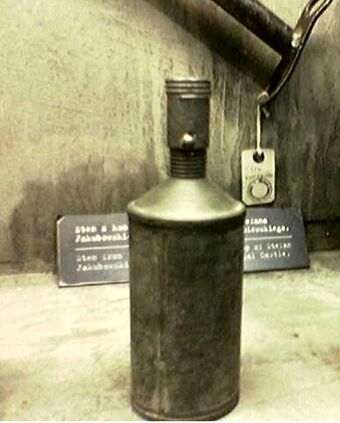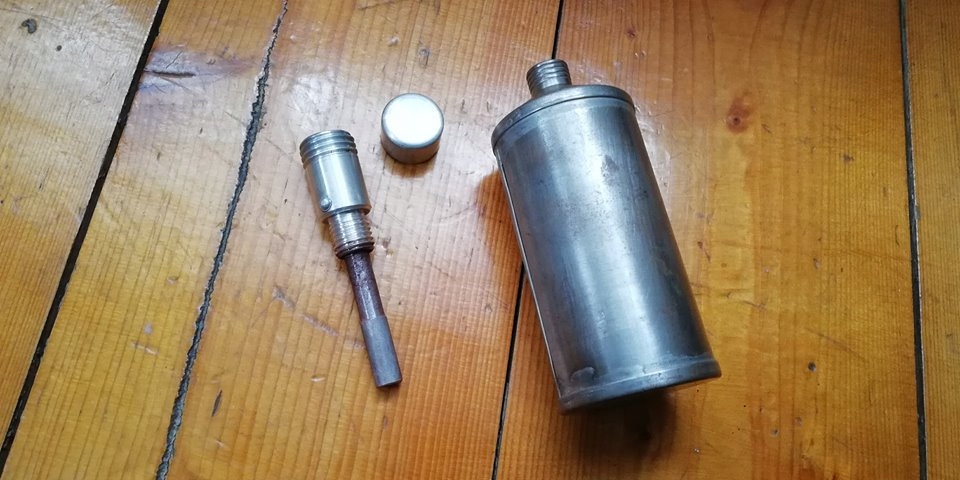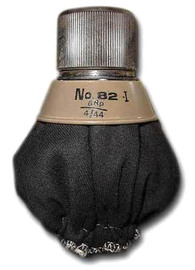Post by Bonobo on Jun 20, 2020 9:05:01 GMT 1
Grenades go first
en.wikipedia.org/wiki/Sidol%C3%B3wka
Sidolówka (pron. seedoloofka) was an unofficial, yet common, name of the R wz. 42 hand grenade, produced by the Polish resistance organization Armia Krajowa in occupied Poland during World War II.
The name of the grenade came from Sidol, a metal-cleaning agent from Henkel sold in Poland at the time. The first grenades used the Sidol bottles as the casing. Later on the casing was purposely modelled after the bottle in order to allow for easier hiding of the weapon.
Production in an underground facility in Lwów
Sidolówka was first produced in Warsaw in 1942, by the professors of the Warsaw University of Technology under the leadership of Jan Czochralski. It was partially based on an earlier design of the Filipinka grenade, also of underground construction, which in turn was based on a pre-war Polish ET-38 anti-tank grenade. The primer and the detonator were designed by two engineers of the pre-war Polish munition works in Warsaw, pyrotechnician Władysław Pankowski and engineer Józef Michałowski.
It was a fragmentation grenade with a P-42 friction primer and a 4.5 second delay time. Until the end of World War II, an estimate of 350,000 R-42 were produced in Polish underground factories. A large number of such grenades were used in the Warsaw Uprising and other battles of the Operation Tempest.



en.wikipedia.org/wiki/Filipinka
Filipinka (also Wańka, Perełka) was a commonly used unofficial name for the ET wz. 40 homemade hand grenade produced for the Armia Krajowa during World War II in occupied Poland.
It was designed by a former worker of the Rembertów Polish Army munition works, Edward Tymoszak (hence the ET abbreviation). It was partially based on his pre-war design of an ET wz. 38 anti-tank grenade.
The Filipinka was an offensive impact grenade, cylindrical in shape. In the upper part of the shell a screw for the fuse was located. Coating of the first series (roughly 4,000 produced) was made of Bakelite, which shattered without producing fragments like a metal-bodied grenade. Later the shell was replaced with a metal impress. The filling was composed mostly of home-made explosives, either cheddite or ammonal. At times explosives from German air bombs and artillery shells, as well as British plastic explosive delivered through air bridges was used. The grenade was equipped with a contact fuze which functioned on impact with the target.
The coating was painted with various colours to allow for easier usage in resistance service and easier hiding. After 1941 all grenades were marked with an inscription in Russian (Desantnaya Udarnaya Granata 41 - Paratroopers' Impact Grenade Mark 41) in order to conceal the real origin of the weapon and ensure the safety of the production facilities. Throughout the war approximately 240,000 grenades of this type were produced. Many of them were used in various battles of the Operation Tempest, including the Warsaw Uprising.


Or, to quicken the production, Warsaw insurgents made bag grenades


en.wikipedia.org/wiki/Sidol%C3%B3wka
Sidolówka (pron. seedoloofka) was an unofficial, yet common, name of the R wz. 42 hand grenade, produced by the Polish resistance organization Armia Krajowa in occupied Poland during World War II.
The name of the grenade came from Sidol, a metal-cleaning agent from Henkel sold in Poland at the time. The first grenades used the Sidol bottles as the casing. Later on the casing was purposely modelled after the bottle in order to allow for easier hiding of the weapon.
Production in an underground facility in Lwów
Sidolówka was first produced in Warsaw in 1942, by the professors of the Warsaw University of Technology under the leadership of Jan Czochralski. It was partially based on an earlier design of the Filipinka grenade, also of underground construction, which in turn was based on a pre-war Polish ET-38 anti-tank grenade. The primer and the detonator were designed by two engineers of the pre-war Polish munition works in Warsaw, pyrotechnician Władysław Pankowski and engineer Józef Michałowski.
It was a fragmentation grenade with a P-42 friction primer and a 4.5 second delay time. Until the end of World War II, an estimate of 350,000 R-42 were produced in Polish underground factories. A large number of such grenades were used in the Warsaw Uprising and other battles of the Operation Tempest.

en.wikipedia.org/wiki/Filipinka
Filipinka (also Wańka, Perełka) was a commonly used unofficial name for the ET wz. 40 homemade hand grenade produced for the Armia Krajowa during World War II in occupied Poland.
It was designed by a former worker of the Rembertów Polish Army munition works, Edward Tymoszak (hence the ET abbreviation). It was partially based on his pre-war design of an ET wz. 38 anti-tank grenade.
The Filipinka was an offensive impact grenade, cylindrical in shape. In the upper part of the shell a screw for the fuse was located. Coating of the first series (roughly 4,000 produced) was made of Bakelite, which shattered without producing fragments like a metal-bodied grenade. Later the shell was replaced with a metal impress. The filling was composed mostly of home-made explosives, either cheddite or ammonal. At times explosives from German air bombs and artillery shells, as well as British plastic explosive delivered through air bridges was used. The grenade was equipped with a contact fuze which functioned on impact with the target.
The coating was painted with various colours to allow for easier usage in resistance service and easier hiding. After 1941 all grenades were marked with an inscription in Russian (Desantnaya Udarnaya Granata 41 - Paratroopers' Impact Grenade Mark 41) in order to conceal the real origin of the weapon and ensure the safety of the production facilities. Throughout the war approximately 240,000 grenades of this type were produced. Many of them were used in various battles of the Operation Tempest, including the Warsaw Uprising.


Or, to quicken the production, Warsaw insurgents made bag grenades








